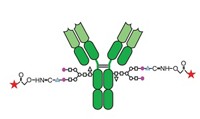Advertisement
Grab your lab coat. Let's get started
Welcome!
Welcome!
Create an account below to get 6 C&EN articles per month, receive newsletters and more - all free.
It seems this is your first time logging in online. Please enter the following information to continue.
As an ACS member you automatically get access to this site. All we need is few more details to create your reading experience.
Not you? Sign in with a different account.
Not you? Sign in with a different account.
ERROR 1
ERROR 1
ERROR 2
ERROR 2
ERROR 2
ERROR 2
ERROR 2
Password and Confirm password must match.
If you have an ACS member number, please enter it here so we can link this account to your membership. (optional)
ERROR 2
ACS values your privacy. By submitting your information, you are gaining access to C&EN and subscribing to our weekly newsletter. We use the information you provide to make your reading experience better, and we will never sell your data to third party members.
Pharmaceuticals
Disulfide Bond Helps Cancer Prodrugs Assemble Into Nanoparticles
Nanomedicine: The simple trick could be a low-cost method to form particles from a range of drug molecules
by Prachi Patel
September 19, 2014

Chemists have coaxed anticancer prodrugs to form easy-to-deliver nanoparticles by inserting a single disulfide bond into the molecules (Nano Lett. 2014, DOI: 10.1021/nl502044x). The nanoparticles carry more drug molecules per weight than commercial forms of the medications. The easy, versatile method works for several different kinds of cancer drugs and could produce nanomedicines reliably and affordably on a large scale, the researchers say.
Nanomedicines could help doctors target tumors and spare healthy tissue because the leaky blood vessels feeding tumors allow the particles to accumulate in the cancerous tissue. Self-assembly is a promising method for engineering these nanodrugs. In recent years, researchers have attached polymers and proteins to cancer drugs such as docetaxel and paclitaxel to make prodrugs that form nanoparticles. The Food & Drug Administration has already approved a paclitaxel nanotherapy called Abraxane for clinical use.
But most nanodrugs studied so far are complex and expensive to make on a large scale, says Yongjun Wang of Shenyang Pharmaceutical University, in China. They are also unstable and don’t carry much of the drug by weight. “These barriers limit the bench-to-bedside translation of nanomedicine,” Wang says.
To get around those barriers, the researchers tried simply linking an anticancer drug to a small molecule with a disulfide bond. If these compounds formed nanoparticles, the reducing environment inside tumor cells would cleave the disulfide bonds and release the drug molecules. So the scientists made a collection of disulfide-bridged compounds: vitamin E and either the drug paclitaxel or doxorubicin, as well as stearic acid with either the drug fluorouracil or gemcitabine.
To make the disulfide-linked compounds, they first converted dithiodiglycolic acid into the corresponding anhydride and then reacted it with either vitamin E or stearic acid. This produced a compound with a free carboxylic acid, which they used to couple their drug molecule of choice.

Forming the nanoparticles was simple. The researchers dissolved the linked compound in ethanol and then added water drop by drop while stirring at room temperature. The molecules spontaneously formed spherical nanoparticles. The researchers ran a series of experiments to understand the role of the disulfide bond and hypothesize that it favors nanoparticle formation because it promotes interactions between prodrug molecules but thwarts crystal formation.
Computer simulations of the self-assembly of paclitaxel-vitamin E particles indicated that four of the paclitaxel-vitamin E molecules huddled together to form the nanoparticles. Light-scattering measurements showed that the paclitaxel-vitamin E particles were about 113 nm wide. The nanoparticles were stable for more than two months. And they packed in more drug molecules than commercially available paclitaxel forms. The particles were 60% paclitaxel by weight, compared with 10% for the nanodrug Abraxane. The injectable drug Taxol—a solution of paclitaxel, castor oil, and ethanol—contains just 1 wt % paclitaxel.
To evaluate the paclitaxel-vitamin E particles’ effectiveness, the team tested them in mice carrying skin cancer tumors. They injected some mice with Taxol and others with the new nanoparticles. After 12 days, tumors treated with Taxol were six times larger by volume, but those treated with the nanoparticles hadn’t even doubled in size.
“This is a very versatile and relatively easy means to make nanomedicines,” says Timothy E. Long, a chemist at Virginia Tech. Self-assembly is tricky and hard to predict, Long says, but the new work could yield an entire family of nanodrugs that are perfectly sized for uptake by tumors.





Join the conversation
Contact the reporter
Submit a Letter to the Editor for publication
Engage with us on Twitter